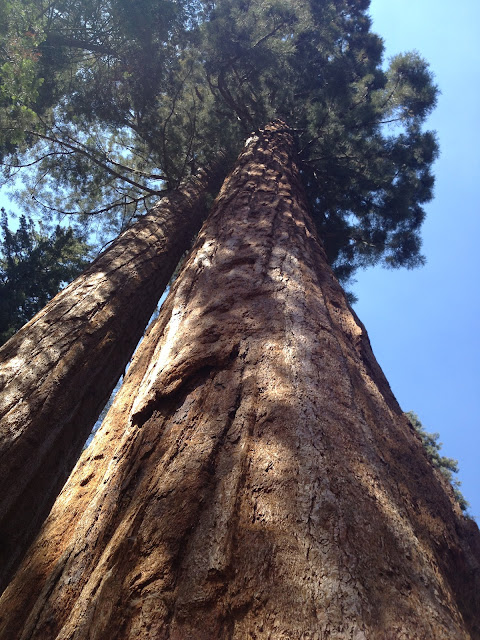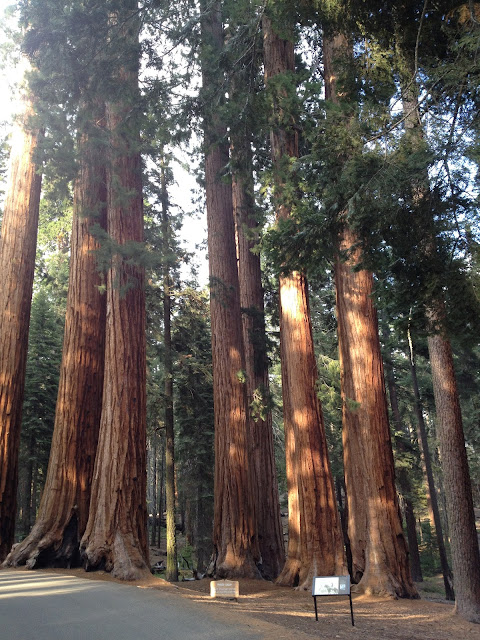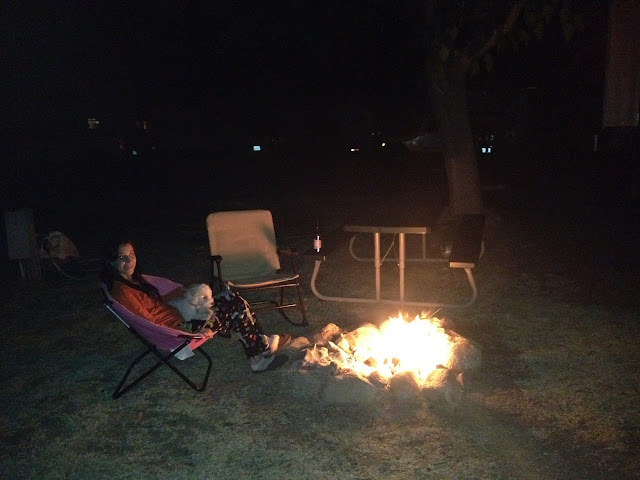First off...This is a long one. But lots of cool info on Squoias!
In Sequoia, we stayed in the most AMAZING CAMPGROUND!! Shawn got there first and called to tell me our site was horrible. Then I arrived to see this!
Of course, he somehow managed to have the site manager "upgrade" us to the deck site and yet somehow pay less. He's like a magician!
Campground video:
In the morning, we headed off to the Sequoia National Park. Wow. The minute you get into "The Giant Forest," you start to see the biggest trees you've ever seen. And then you find out that they're babies compared to General Sherman (By volume, it is the largest known living single stem tree on Earth)
One of the first trees we saw. Look at Shawn at the bottom of the picture...he's in an orange shirt. You can hardly see him, because the tree is so big!
BIG!
BIGGER!!
One of the interesting things we learned is that natural fires are actually good for forests. The Sequoias are built to withstand the flames and heat and the fires serve to clear the forest floor of debris so new organisms can grow better. Mother nature knows what she's doing! In fact, we humans have spent so much effort trying to stop ALL forest fires, that we've kinda messed things up and now have to create prescribed fires on purpose! Only professionals please! Careless man-made fires do not count.
So how do sequoias survive fires?
Thick bark with many air pockets insulates the wood from heat. With little sap or pitch in it, the bark is not very flammable. High branches hold foliage well above most fires. With competing plants burned away, surviving trees get more water, nutrients, and sun.
SEE: http://www.nps.gov/hfc/pdf/waysides/seki-trail-all.pdf
More on the following facts can be seen at:
http://www.sequoiaministriesinternational.org/about-us/learn-more-about-giant-sequoias
How did park rangers figure out that fire has always been a part of Sequoia and Kings Canyon?
They asked the trees! Trees grow and add on a ring of wood just under their bark every year. If a fire is hot enough, its heat will penetrate the bark and burn rings, leaving a scar. These scars show up as black, warped lines and they are easy to spot in a cross-section of a tree. Because of the scars, tree rings have a lot of information etched in their wood.
Here is a tree where you can see the years that fires occurred by looking at the bark's burn marks.
Before and after a fire
A prescribed fire that was going on when we were there.
 It is curious that we humans think we know best, even though some of
these trees have survived over 3,000 years, through droughts, floods and
fires, without our help. The natural world is such a perfectly
functioning complex system with different organisms and species working
together so that they all survive and even flourish. If only our
government could learn a bit from it...
It is curious that we humans think we know best, even though some of
these trees have survived over 3,000 years, through droughts, floods and
fires, without our help. The natural world is such a perfectly
functioning complex system with different organisms and species working
together so that they all survive and even flourish. If only our
government could learn a bit from it...
For example:
Below is a (terrible) picture of General Sherman next to some other big things you may know. Just to give you some perspctive...
General Sherman is the thickest tree. To it's right is the tallest tree in the world...a redwood. General Sherman is almost 100 yards tall (imagine it lying on a football field and taking up the whole thing)
If you were to put the tree on a highway, it would block three lanes of traffic.
Here is is from afar. It is the thick one on the left. If you look closely, you can sort of see some people down by it.
You're not allowed to actually go up to this tree, so it's hard to tell just how wide it is. We're pretty far from it in this picture.
Here you can see a bit better. Check out the guy in the white shirt to the right of this monstrous specimen.
 After seeing General Sherman, we were driving along the road when we suddenly came across a bunch of people pulled over, taking pictures. We didn't know what they were looking at, but figured it must be something cool. This is what we thought it was. I was walking towards it when I heard Shawn hissing at me. I looked up to see a big brown bear about 35 feet away!!!
After seeing General Sherman, we were driving along the road when we suddenly came across a bunch of people pulled over, taking pictures. We didn't know what they were looking at, but figured it must be something cool. This is what we thought it was. I was walking towards it when I heard Shawn hissing at me. I looked up to see a big brown bear about 35 feet away!!!
Tada!!
AND THEN WE SAW THIS LITTLE THING CLIMBING DOWN A TREE TO JOIN ITS MOMMY!!
Some very cool videos of the moment.
http://youtu.be/yckE1hl49_8
http://youtu.be/jpQXhTm-zvQ
In Sequoia, we stayed in the most AMAZING CAMPGROUND!! Shawn got there first and called to tell me our site was horrible. Then I arrived to see this!
Of course, he somehow managed to have the site manager "upgrade" us to the deck site and yet somehow pay less. He's like a magician!
Campground video:
In the morning, we headed off to the Sequoia National Park. Wow. The minute you get into "The Giant Forest," you start to see the biggest trees you've ever seen. And then you find out that they're babies compared to General Sherman (By volume, it is the largest known living single stem tree on Earth)
One of the first trees we saw. Look at Shawn at the bottom of the picture...he's in an orange shirt. You can hardly see him, because the tree is so big!
BIG!
BIGGER!!
One of the interesting things we learned is that natural fires are actually good for forests. The Sequoias are built to withstand the flames and heat and the fires serve to clear the forest floor of debris so new organisms can grow better. Mother nature knows what she's doing! In fact, we humans have spent so much effort trying to stop ALL forest fires, that we've kinda messed things up and now have to create prescribed fires on purpose! Only professionals please! Careless man-made fires do not count.
So how do sequoias survive fires?
Thick bark with many air pockets insulates the wood from heat. With little sap or pitch in it, the bark is not very flammable. High branches hold foliage well above most fires. With competing plants burned away, surviving trees get more water, nutrients, and sun.
SEE: http://www.nps.gov/hfc/pdf/waysides/seki-trail-all.pdf
More on the following facts can be seen at:
http://www.sequoiaministriesinternational.org/about-us/learn-more-about-giant-sequoias
- Believe it or not, Giant Sequoias are dependent on fire for survival. Studies revealed that fire could be used as a management tool, at least in small areas, and that it would not only reduce fire hazard, but would stimulate the regeneration of Giant Sequoias in many ways. Scientists confirmed that Giant Sequoia reproduction effectively dropped to zero in groves where fires were not allowed to burn.
- Not only is the Giant Sequoia adapted to live with fire, it gains benefit from the association. For example, rapid growth occurs after a fire. Rising heat from a fire dries out the hanging Sequoia cones which open up, allowing seeds to rain by the millions. These seeds land on cleared soil fertilized by ash. On soil left bare by fire, they can take root. Giant Sequoia seed germination naturally occurs best in fire-burned, mineral-rich soils.
- Sequoia seedlings are much more likely to survive where fire burned hottest. Clusters of Giant Sequoias may be found where fire once burned very hot, called a Hot Spot. Because the shade canopy is destroyed, those remaining plants that can tolerate high light intensities will be favored. The Giant Sequoia is such a plant.
How did park rangers figure out that fire has always been a part of Sequoia and Kings Canyon?
They asked the trees! Trees grow and add on a ring of wood just under their bark every year. If a fire is hot enough, its heat will penetrate the bark and burn rings, leaving a scar. These scars show up as black, warped lines and they are easy to spot in a cross-section of a tree. Because of the scars, tree rings have a lot of information etched in their wood.
Here is a tree where you can see the years that fires occurred by looking at the bark's burn marks.
Before and after a fire
A prescribed fire that was going on when we were there.
- Giant Sequoias are Fire- Resistant, but not Fireproof. The thicker bark will not hold a flame, but the bark can be seared through when accumulations of fuel beneath the tree burn for a long time. The deep and long fire scars that can be seen on many Giant Sequoia trunks are probably due to the heat of the burning, less fire-resistant adjacent trees.

- Sequoias Heal. Giant Sequoias have an amazing ability to heal when injured. Often despite severe fire damage (some burned completely hollow)
- Giant Sequoias can survive for centuries. Continually new wood grows from either side of a fire scar, covering a little more each year until the injury is healed over like new skin on a body. Cross-sections of logged Sequoias disclose many cases where fire scars have completely healed after the damage was incurred.
 It is curious that we humans think we know best, even though some of
these trees have survived over 3,000 years, through droughts, floods and
fires, without our help. The natural world is such a perfectly
functioning complex system with different organisms and species working
together so that they all survive and even flourish. If only our
government could learn a bit from it...
It is curious that we humans think we know best, even though some of
these trees have survived over 3,000 years, through droughts, floods and
fires, without our help. The natural world is such a perfectly
functioning complex system with different organisms and species working
together so that they all survive and even flourish. If only our
government could learn a bit from it...For example:
- Sequoias help each other. Giant Sequoias do not compete with each other for resources, rather their huge root systems fuse together and they share resources.
- Sequoias naturally form partnerships. Like most living organisms, the Giant Sequoia does not live alone; it is but one member of a complex association of plants and animals whose continued existence depends on interdependence of physical and living components. For example, the Giant Sequoia lacks the ability to drop its own cones; a mature Sequoia tree carries thousands of cones. These cones hang on a tree with its seeds sealed up for up to 20 years until something opens them. Two very small forest residents act as seed dispersing agents for the Giant Sequoia: the tiny, Long-horned Wood-boring Beetle and the Chickaree or Douglas Squirrel.
- Sequoias are interdependent and their well-being depends on reciprocal arrangement of services. Both the beetle and the Chickaree for example receive nourishment from the Giant Sequoia cones, and in exchange they assist the seeds to be released, greatly increasing the chances of Giant Sequoia reproduction. Interestingly, the Chickarees seem to prefer cones between two and five years old, while the beetle apparently prefers cones four years or older.
Below is a (terrible) picture of General Sherman next to some other big things you may know. Just to give you some perspctive...
General Sherman is the thickest tree. To it's right is the tallest tree in the world...a redwood. General Sherman is almost 100 yards tall (imagine it lying on a football field and taking up the whole thing)
If you were to put the tree on a highway, it would block three lanes of traffic.
Here is is from afar. It is the thick one on the left. If you look closely, you can sort of see some people down by it.
You're not allowed to actually go up to this tree, so it's hard to tell just how wide it is. We're pretty far from it in this picture.
Here you can see a bit better. Check out the guy in the white shirt to the right of this monstrous specimen.
 After seeing General Sherman, we were driving along the road when we suddenly came across a bunch of people pulled over, taking pictures. We didn't know what they were looking at, but figured it must be something cool. This is what we thought it was. I was walking towards it when I heard Shawn hissing at me. I looked up to see a big brown bear about 35 feet away!!!
After seeing General Sherman, we were driving along the road when we suddenly came across a bunch of people pulled over, taking pictures. We didn't know what they were looking at, but figured it must be something cool. This is what we thought it was. I was walking towards it when I heard Shawn hissing at me. I looked up to see a big brown bear about 35 feet away!!!Tada!!
AND THEN WE SAW THIS LITTLE THING CLIMBING DOWN A TREE TO JOIN ITS MOMMY!!
Some very cool videos of the moment.
http://youtu.be/yckE1hl49_8
http://youtu.be/jpQXhTm-zvQ






























That was fascinating information!!! I now realize how very little I knew about the sequoias. The photos are spectacular and I love the shots of the scenic walkway. Wow! It is so great to see that you are back on the blog. Yay!!!
ReplyDelete